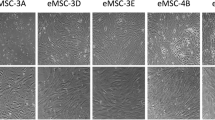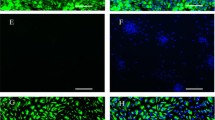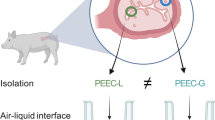Abstract
Glandular epithelial cells (GE) in the endometrium are thought to support the elongation and survival of ruminant embryos by secreting histotrophs. In the present study, the gene expression of bovine endometrial epithelial cells cultured in matrigel was analyzed and examined whether it could be an in vitro model of GE. Bovine endometrial epithelial cells (BEE) and stromal cells (BES) were isolated from the slaughterhouse uteri and cultured in DMEM/F12 + 10% FBS. BEE showed the gland-like structure morphological changes when cultured in 15% matrigel but could not be identified in higher concentrations of the matrigel (30% or 60%). The expression of typical genes expressed in GE, SERPINA14 and GRP, was substantially high in matrigel-cultured BEE than in monolayer (P < 0.05). P4 and INFα have no significant effect on the SERPINA14 expression of BEE cultured in matrigel without co-culture with BES. On the other hand, when BEE were co-cultured with BES in matrigel culture, the expression of FGF13 was increased by the P4 treatment (P < 0.05). Furthermore, SERPINA14 and TXN expressions were increased by P4 + IFNα treatment (P < 0.05). These results demonstrate the appropriate conditions for BEE to form glandular structures in matrigel and the effect of co-culture with BES. The present study highlighted the possible use of matrigel for the culture of BEE to investigate the expression of cell-specific glandular epithelial genes as well as P4 and type-I IFN as factors controlling endometrial function during the implantation period.






Similar content being viewed by others
References
Bartol FF, Wiley AA, Floyd JG, Ott TL, Bazer FW, Gray CA, Spencer TE (1999) Uterine differentiation as a foundation for subsequent fertility. J Reprod Fertil Suppl 54:287–302
Bazer FW, Spencer TE, Johnson GA (2009) Interferons and uterine receptivity. Semin Reprod Med 27(1):90–102
Cooke PS, Ekman GC, Kaur J, Davila J, Bagchi IC, Clark SG, Dziuk PJ, Hayashi K, Bartol FF (2012) Brief exposure to progesterone during a critical neonatal window prevents uterine gland formation in mice. Biol Reprod 86(63):1–10
Cooke PS, Uchima FA, Fujii DK, Bern HA, Cunha GR (1986) Restoration of normal morphology and estrogen responsiveness in cultured vaginal and uterine epithelial transplanted with stroma. Proc Natl Acad Sci USA 83:2109–2113
Cunha GR, Bigsby RM, Cooke PS, Sugimura Y (1985) Stromal-epithelial interactions in adult organs. Cell Differ 17:137–148
Davis DL, Blair RM (1993) Secretory products of the porcine endometrium: studies of uterine secretions and products of primary cultures of endometrial cells. J Reprod Fertil Suppl 48:143–155
Diskin MG, Morris DG (2008) Embryonic and early foetal losses in cattle and other ruminants. Reprod Domest Anim 43(Suppl 2):260–267
Diskin MG, Murphy JJ, Sreenan JM (2006) Embryo survival in dairy cows managed under pastoral conditions. Anim Reprod Sci 96:297–311
Eritja N, Llobet D, Domingo M, Santacana M, Yeramian A, Matias-Guiu X, Dolcet X (2010) A novel three-dimensional culture system of polarized epithelial cells to study endometrial carcinogenesis. Am J Pathol 176:2722–2731
Filant J, Spencer TE (2013) Endometrial glands are essential for blastocyst implantation and decidualization in the mouse uterus. Biol Reprod 88:93
Forde N, McGettigan PA, Mehta JP, O’Hara L, Mamo S, Bazer FW, Spencer TE, Lonergan P (2014) Proteomic analysis of uterine fluid during the pre-implantation period of pregnancy in cattle. Reproduction 147(5):575–587
Gospodarowicz D, Vlodavsky I, Savion N, Tauber JP (1980) Control of the proliferation and differentiation of vascular endothelial cells by fibroblast growth factor. Soc Gen Physiol Ser 35:1–38
Gray CA, Abbey CA, Beremand PD, Choi Y, Farmer JL, Adelson DL, Thomas TL, Bazer FW, Spencer TE (2006) Identification of endometrial genes regulated by early pregnancy, progesterone, and interferon tau in the ovine uterus. Biol Reprod 74:383–394
Gray CA, Burghardt RC, Johnson GA, Bazer FW, Spencer TE (2002) Evidence that absence of endometrial gland secretions in uterine gland knockout ewes compromises conceptus survival and elongation. Reproduction 124:289–300
Gray CA, Taylor KM, Ramsey WS, Hill JR, Bazer FW, Bartol FF, Spencer TE (2001) Endometrial glands are required for preimplantation conceptus elongation and survival. Biol Reprod 64:1608–1613
Haeger JD, Loch C, Pfarrer C (2018) The newly established bovine endometrial gland cell line (BEGC) forms gland acini in vitro and is only IFNτ-responsive (MAPK42/44 activation) after E2 and P4-pre-incubation. Placenta 67:61–69
Hughes CS1, Postovit LM, Lajoie GA (2010) Matrigel: a complex protein mixture required for optimal growth of cell culture. Proteomics 10(9):1886–1890
Ireland JJ, Murphee RL, Coulson PB (1980) Accuracy of predicting stages of bovine estrous cycle by gross appearance of the corpus luteum. J Dairy Sci 63:155–160
Khodabandeh Z, Vojdani Z, Talaei-Khozani T, Bahmanpour S (2017) Hepatogenic differentiation capacity of human Wharton’s jelly mesenchymal stem cell in a co-culturing system with endothelial cells in Matrigel/collagen scaffold in the presence of fetal liver extract. Int J Stem Cells 10:218–226
Lee EY, Parry G, Bissell MJ (1984) Modulation of secreted proteins of mouse mammary epithelial cells by the collagenous substrata. J Cell Biol 98:146–155
Lu H, Shi X, Wu G, Zhu J, Song C, Zhang Q, Yang G (2015) FGF13 regulates proliferation and differentiation of skeletal muscle by down-regulating Spry1. Cell Prolif 48:550–560
Musavi SAA, Yamashita S, Fujihara T, Masaka H, Islam MR, Kim S, Gotoh T, Kawahara M, Tashiro K, Yamauchi N (2018) Analysis of differentially expressed genes and the promoters in bovine endometrium throughout estrus cycle and early pregnancy. Anim Sci J 89(11):1609–1621
Rahman AMI, Yamashita S, Islam MR, Fujihara T, Yamaguchi H, Kawahara M, Takahashi M, Takahashi H, Goto T, Yamauchi N (2020) Type-I interferon regulates matrix metalloproteinases clearance of the bovine endometrial cells in vitro. Anim Sci J 91(1):e13350
Rinehart CA Jr, Lyn-Cook BD, Kaufman DG (1988) Gland formation from human endometrial epithelial cells in vitro. Vitro Cell Dev Biol 24(10):1037–1041
Spencer TE, Bazer FW (1995) Temporal and spatial alterations in uterine estrogen receptor and progesterone receptor gene expression during the estrous cycle and early pregnancy in the ewe. Biol Reprod 53:1527–1543
Spencer TE, Kelleher AM, Bartol FF (2019) Development and function of uterine glands in domestic animals. Annu Rev Anim Biosci 7:125–147
Stewart MD, Johnson GA, Bazer FW, Spencer TE (2001) Interferon-tau (IFNtau) regulation of IFN-stimulated gene expression in cell lines lacking specific IFN-signaling components. Endocrinology 142(5):1786–1794
Su YJ, Huang SY, Ni YH, Liao KF, Chiu SC (2018) Anti-tumor and radiosensitization effects of N-butylidenephthalide on human breast cancer cells. Molecules 23(2). pii: E240. https://doi.org/10.3390/molecules23020240
Thomas TE, Stadler E, Dziadek M (1992) Effects of the extracellular matrix on fetal choroid plexus epithelial cells: changes in morphology and multicellular organization do not affect gene expression. Exp Cell Res 203:198–213
Yamauchi N, Yamada O, Takahashi T, Imai K, Sato T, Ito A, Hashizume K (2003) A three-dimensional cell culture model for bovine endometrium: regeneration of a multicellular spheroid using ascorbate. Placenta 24(2–3):258–269
Yamagami K, Yamauchi N, Kubota K, Nishimura S, Chowdhury VS, Yamanaka K, Takahashi M, Tabata S, Hattori MA (2014) Expression and regulation of Foxa2 in the rat uterus during early pregnancy. J Reprod Dev 60(6):468–475
Funding
This work was supported by the Grant-in-Aid for Scientific Research from the Ministry of Education, Science, Sports, and Culture of Japan (grant no. 19K22311).
Author information
Authors and Affiliations
Corresponding author
Ethics declarations
Ethical approval
The animals used in this study were treated according to the guidelines for Animal Experiments in the Faculty of Agriculture of Kyushu University (no. A19-297-0) and the laws of the Japanese Government (Law no. 105 with notification no. 6).
Conflict of interest
The authors declare that they have no conflict of interest.
Additional information
Publisher’s Note
Springer Nature remains neutral with regard to jurisdictional claims in published maps and institutional affiliations.
Summary sentence: Gene expressions of bovine endometrial epithelial cells cultured in matrigel were analyzed. The cells showed the gland-like structure when cultured in 15% matrigel. The expression of FGF13, SEPARINA14, and TXN was increased when the cells were co-cultured in matrigel with endometrial stromal.
Rights and permissions
About this article
Cite this article
Nishino, D., Kotake, A., Yun, C.S. et al. Gene expression of bovine endometrial epithelial cells cultured in matrigel. Cell Tissue Res 385, 265–275 (2021). https://doi.org/10.1007/s00441-021-03418-7
Received:
Accepted:
Published:
Issue Date:
DOI: https://doi.org/10.1007/s00441-021-03418-7




